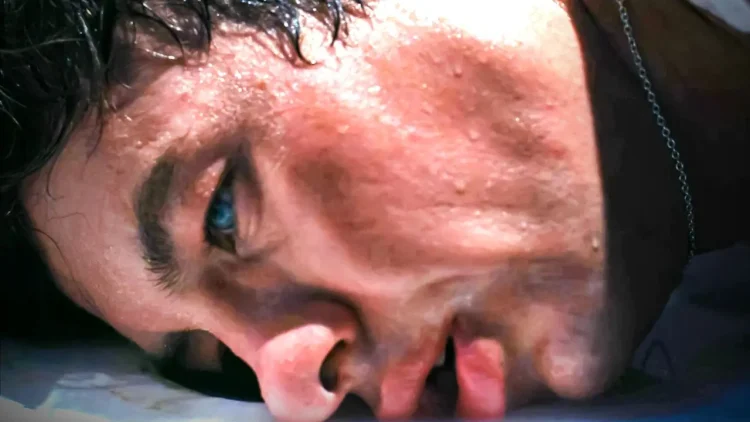How to Make the Most of a Bathtub Scene

The scene uses its luxurious setting to explore themes of wealth and indulgence. The grandiose bathroom and extravagant bath products symbolize the excesses of the Saltburn family’s lifestyle. Felix’s presence in this setting underscores his internal struggle between the allure of wealth and the reality of his own background.
2. Isolation and Introspection
The bathtub scene represents a moment of solitude for Felix. The private, enclosed space allows him to reflect on his situation and emotions. This introspection is visually represented through the scene’s serene environment and the character’s contemplative demeanor.
3. Moral Ambiguity
The scene also touches on the moral ambiguities of wealth and power. Felix’s immersion into the Saltburn family’s world prompts questions about the ethics of pursuing wealth and the costs of indulgence. The bathtub, as a symbol of both comfort and excess, reflects these complex themes.
4. The Illusion of Happiness
The scene critiques the idea that wealth and luxury equate to happiness. Despite the opulence surrounding him, Felix is depicted as conflicted and uncertain. This contrast highlights the film’s exploration of the superficial nature of material wealth.
Comparing the Saltburn Bathtub Scene to Other Iconic Bathtub Scenes
To appreciate the significance of the Saltburn bathtub scene, it is helpful to compare it to other famous bathtub scenes in film history.
1. “Psycho” (1960)
In Alfred Hitchcock’s Psycho, the bathtub scene is a pivotal moment of suspense and horror. Unlike Saltburn’s luxurious and introspective setting, this scene is tense and foreboding, using the bathtub as a stage for a shocking revelation.
2. “Roman Holiday” (1953)
Roman Holiday features a charming and playful bathtub scene that serves to develop the romantic chemistry between the characters. In contrast to Saltburn’s themes of wealth and moral ambiguity, this scene focuses on joy and adventure.
3. “The Shape of Water” (2017)
Guillermo del Toro’s The Shape of Water uses the bathtub scene to explore themes of love and connection. The intimacy of the scene and the emotional connection between the characters offer a stark contrast to the superficial luxury of Saltburn’s bathtub scene.
Conclusion
The bathtub scene in Saltburn is a masterful example of how a seemingly simple setting can be used to explore complex themes and character dynamics. Through its luxurious visual design, thoughtful sound design, and nuanced performances, the scene serves as a critical juncture in the film’s narrative.
By examining the techniques used in the Saltburn bathtub scene, we can gain insights into how to craft powerful and memorable moments in film. From the symbolic use of luxury to the exploration of wealth and power, this scene exemplifies how a well-executed bathtub scene can elevate a film’s emotional and thematic impact.
Understanding the Bathtub Scene: Its Significance and Potential
The Symbolism of the Bathtub
character’s desire for a fresh start or a moment of vulnerability. By understanding the symbolism associated with bathtubs, you can craft scenes that resonate on a deeper level with your audience.
Purification and Renewal: The act of bathing is often associated with cleansing and renewal. This can be used to signify a character’s attempt to wash away past mistakes or start anew.
Introspection and Reflection: Bathtubs provide a private space where characters can reflect on their thoughts and feelings. This setting allows for deep, introspective moments that can reveal important aspects of a character’s psyche.
Escape and Solitude: A bathtub scene can serve as a retreat from the outside world. It offers a moment of solitude where characters can escape from the pressures and conflicts of their daily lives.
Narrative Uses of the Bathtub Scene
Bathtub scenes can serve various narrative functions, including:
Character Development: These scenes can reveal a character’s inner thoughts and emotions, providing insight into their personal struggles and growth.
Plot Advancement: A well-crafted bathtub scene can move the plot forward by introducing new conflicts or resolving existing ones.
Emotional Impact: The intimacy of a bathtub scene can heighten emotional tension, making it a powerful tool for conveying feelings of sadness, joy, or contemplation.
Crafting a Memorable Bathtub Scene
Setting the Scene
The setting of a bathtub scene is crucial to its effectiveness. Consider the following elements to create an immersive and engaging environment:
1. Visual Aesthetics
The visual presentation of the bathtub scene sets the tone and mood. Pay attention to:
- Lighting: Soft, ambient lighting can create a serene and contemplative atmosphere. Use candles, dimmed lights, or natural light from windows to achieve the desired effect.
- Background: The background should complement the scene’s mood. A clean, minimalist bathroom might convey tranquility, while a cluttered, old-fashioned tub could suggest a more nostalgic or reflective moment.
- Props: Incorporate props that enhance the scene. Bubbles, bath salts, or a rubber ducky can add layers of meaning or create visual interest.
2. Sound Design
Sound plays a crucial role in a bathtub scene. Consider:
- Background Music: Choose music that reflects the mood you want to convey. Gentle, instrumental music can create a calming effect, while upbeat or dramatic scores can heighten tension.
- Ambient Sounds: The sound of water dripping, splashing, or the gentle hum of a faucet can add realism and immersion to the scene.
3. Costume and Appearance
The character’s appearance in the bathtub can influence the scene’s tone:
- Costumes: Characters can be dressed in bathrobes, pajamas, or swimwear. Their attire should align with the scene’s emotional context and narrative purpose.
- Appearance: Pay attention to hair, makeup, and overall appearance. Characters might be in a relaxed state, with wet hair and no makeup, or they might appear more polished, depending on the scene’s intent.
Writing the Scene
When writing a bathtub scene, focus on the following aspects to enhance its effectiveness:
1. Dialogue
Dialogue in a bathtub scene should be purposeful and reflective:
- Subtle Conversations: Characters might engage in deep, philosophical conversations or share intimate thoughts.
- Monologues: A character’s inner monologue can be a powerful way to convey their thoughts and emotions.
2. Emotional Tone
The emotional tone of the scene should align with the narrative’s direction:
- Calm and Reflective: For introspective moments or peaceful scenes.
- Tense and Dramatic: For confrontations or emotional revelations.
3. Descriptive Language
Use descriptive language to bring the scene to life:
- Sensory Details: Describe the feel of the water, the smell of bath products, or the sight of steam rising from the tub.
- Emotional Atmosphere: Convey the character’s feelings through descriptive imagery and mood-setting details.
Filmmaking Techniques
If you’re a filmmaker, consider these techniques to enhance your bathtub scene:
1. Camera Angles and Shots
Different camera angles and shots can convey various aspects of the scene:
- Close-Ups: Capture the character’s emotions and expressions.
- Wide Shots: Show the entire bathroom setting and create a sense of space.
- Over-the-Shoulder Shots: Provide a view of what the character is looking at, adding perspective.
2. Camera Movements
Subtle camera movements can add dynamism to the scene:
- Slow Zooms: Focus on details or emphasize emotions.
- Pans: Follow the character’s movements or explore the environment.
3. Editing Techniques
Editing choices can shape the scene’s rhythm and impact:
- Slow Cuts: Create a contemplative or emotional atmosphere.
- Cross-Cutting: Show interactions or parallel storylines.
Examples of Iconic Bathtub Scenes
To inspire your work, here are a few notable examples of bathtub scenes in film and literature:
1. “Psycho” (1960)
Alfred Hitchcock’s “Psycho” features a memorable bathtub scene that builds suspense and horror. The scene uses sound, lighting, and camera angles to create tension and surprise.
2. “Roman Holiday” (1953)
In “Roman Holiday,” Audrey Hepburn’s character has a charming bathtub scene that showcases her playful side and sets the tone for her romantic adventure.
3. “The Shape of Water” (2017)
Guillermo del Toro’s “The Shape of Water” uses a bathtub scene to explore themes of love and connection. The scene is visually striking and emotionally poignant, demonstrating the power of the bathtub as a setting for intimacy and revelation.
Common Mistakes to Avoid
To ensure your bathtub scene is effective, be aware of these common pitfalls:
1. Overloading the Scene with Exposition
Avoid using the bathtub scene solely as a vehicle for exposition. Instead, let the scene develop organically and focus on the character’s emotional journey.
2. Neglecting Visual and Sensory Details
A bathtub scene can become mundane if visual and sensory details are overlooked. Pay attention to the scene’s aesthetics and atmosphere.
3. Forcing Symbolism
Symbolism should feel natural and not forced. Ensure that any symbolic elements enhance the scene’s emotional or narrative impact.
Conclusion
Creating a memorable and impactful bathtub scene involves a careful balance of visual aesthetics, sound design, and narrative depth. By understanding the symbolic significance of bathtubs and employing effective writing and filmmaking techniques, you can craft scenes that resonate with your audience and serve your story’s goals.





